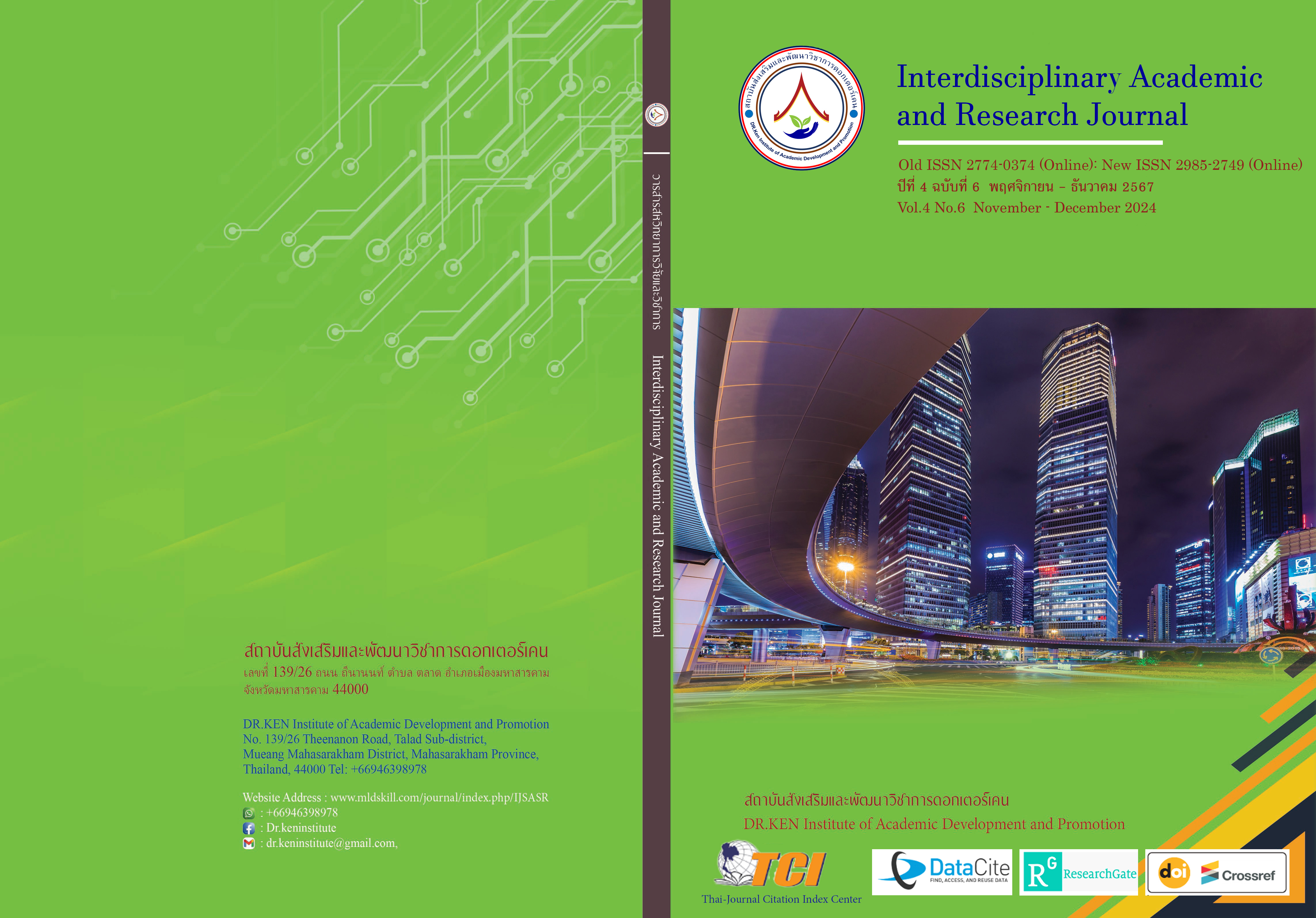Educational Disparity in the Digital Age
DOI:
https://doi.org/10.60027/iarj.2024.278859Keywords:
Disparity, Education, Digital AgeAbstract
Background and Aims: Understanding and addressing the growing gaps in access to high-quality education brought on by socioeconomic factors requires a study of educational disparity in the digital age. This information supports the development of interventions and policies that guarantee all students, regardless of background, have equal access to education. This paper aims to analyze the Educational Disparity in the Digital Age
Methodology: This study is a study of related academic documents and is presented descriptively according to the study objectives.
Results: Education disparity refers to inequality in the quality and standards of education management. This issue is emphasized in the Constitution of the Kingdom of Thailand, Buddhist Era 2540 and 2550, as well as the National Education Act, Buddhist Era 2542, and the National Education Development Plan, Buddhist Era 2560-2579. However, it must be acknowledged that educational parity has not yet been achieved as intended, and educational disparities persist in today's society. During the shift to a new lifestyle in the digital age, with online learning, economic and social disparities directly impact learners. This was evident during COVID-19 when children from affluent families could study uninterrupted at home, with access to modern information technology. In contrast, disadvantaged children face difficulties accessing educational technology and communication tools, perpetuating educational inequality in society.
Conclusion: Thai constitutional provisions and national education policies continue to address the persistent issue of education disparity, which highlights inequality in educational standards and quality. True educational parity is still unachieved despite these efforts, and this is particularly evident now that online learning has become the norm in the digital age. Educational inequality is perpetuated when affluent children struggle while disadvantaged children have unrestricted access to educational technology, as demonstrated by the COVID-19 pandemic and other economic and social disparities.
References
กระทรวงศึกษาธิการ. (2549). แนวทางการจัดกิจกรรมการเรียนรู้เพื่อพัฒนาทักษะการคิดวิเคราะห์. กรุงเทพมหานคร : สำนักวิชาการและมาตรฐานการศึกษาขั้นพื้นฐาน.
กระทรวงศึกษาธิการ. (2563). แผนยุทธศาสตร์กระทรวงศึกษาธิการ (พ.ศ. 2563-2565). ศูนย์เทคโนโลยีสารสนเทศและการสื่อสาร : สำนักงานปลัดกระทรวงศึกษาธิการ.
กองทุนเพื่อความเสมอภาคทางการศึกษา (2561).พระราชบัญญัติ กองทุนเพื่อความเสมอภาคทางการศึกษา พ.ศ. 2561. Retrieved from: https://www.ratchakitcha.soc.go.th/DATA/PDF/2561/A/033/1.PDF
กันต์กมล วราสุนันท์. (2562). การศึกษาคุณลักษณะภาวะผู้นำในยุคดิจิทัลของผู้บริหารสถานศึกษาในโรงเรียนมัธยมศึกษา จังหวัดอุตรดิตถ์. วิทยานิพนธ์ปริญญามหาบัณฑิต. สาขาวิชาการบริหารการศึกษา หลักสูตรการศึกษามหาบัณฑิต มหาวิทยาลัยนเรศวร, พิษณุโลก.
จิณณวัตร ปะโคทัง. (2561). ภาวะผู้นำยุคดิจิทัล สำหรับผู้บริหารสถานศึกษามืออาชีพ. มหาวิทยาลัยราชภัฏอุบลราชธานี.
ณปภัช บรรณาการ และสิวะโชติ ศรีสุทธิยากร. (2562). ความเหลื่อมล้ำทางการศึกษาของนักเรียนในโรงเรียน สังกัดสำนักงานเขตพื้นที่การศึกษามัธยมศึกษา กรุงเทพมหานคร. วารสารอิเล็กทรอนิกส์ทางการศึกษา, 14 (2), 1-11.
ธีรภัทร์ ถิ่นแสนดี และภิญญา อนุพันธ์. (2564). ความเหลื่อมล้ำทางการศึกษาในสถานการณ์การแพร่ระบาดของโรคติดเชื้อไวรัสโคโรนา 2019. ปริญญาครุศาสตรมหาบัณฑิต สาขาวิชาพุทธบริหารการศึกษา บัณฑิตวิทยาลัย มหาวิทยาลัยมหามกุฏราชวิทยาลัย วิทยาเขตร้อยเอ็ด, ร้อยเอ็ด.
นันทิพร ฉัตรแก้วและคณะ. (2562). ยุทธศาสตร์โรงเรียนประชารัฐกับการบริหารการศึกษาในยุคดิจิทัล. Veridian E-Journal, 12(2), 257 -274.
เปรื่อง กิจรัตนภร. (2555). ความเหลื่อมล้ำทางการศึกษาไทย: ที่มาและทางออก. Retrieved from: http://rajabhatnetwork.com/upload/images/Document/Doc%20Preang.pdf, 7 เมษายน 2567.
พระเขมทัต สีลสาโร (รื่นส้าราญ). (2560). การวิเคราะห์นโยบายและยุทธศาสตร์เพื่อลดปัญหาความเหลื่อมล้ำในสังคมไทยอย่างยั่งยืน. วิทยานิพนธ์ปริญญาพุทธศาสรมหาบัณฑิต มหาวิทยาลัยมหาจุฬาลงกรณราชวิทยาลัย, พระนครศรีอยุธยา.
วิโรจน์ ณ ระนอง และคณะ. (2560). โครงการทบทวนตัวชี้วัดศักยภาพชุมชนเพื่อการติดตามยุทธศาสตร์การสร้างความเป็นธรรมและลดความเหลื่อมล้ำในสังคมภายใต้แผนพัฒนาเศรษฐกิจและสังคมแห่งชาติฉบับที่ 12. รายงานการวิจัย. กรุงเทพมหานคร: สำนักงานสภาพัฒนาการเศรษฐกิจและสังคมแห่งชาติ.
สงบ อินทรมณี. (2562). การบริหารสถานศึกษาในยุคดิจิทัล. วารสารวิชาการมหาวิทยาลัยการจัดการและเทคโนโลยีอีสเทิร์น, 16(1), 354-355.
สถาบันส่งเสริมการสอนวิทยาศาสตร์และเทคโนโลยี (สสวท.). (2562). เผยแพร่ข้อสอบ PISA-LIKE ด้านวิทยาศาสตร์และคณิตศาสตร์. Retrieved from: http://www.ipst.ac.th /index.php/news-and-announcements/training-seminar/item/1576-pisa-like, 17 มิถุนายน 2567.
สำนักงานสภาพัฒนาการเศรษฐกิจและสังคมแห่งชาติ. (2566). แผนพัฒนาเศรษฐกิจและสังคมแห่งชาติ ฉบับที่ 13 (พ.ศ. 2566 - 2570). กรุงเทพฯ: สำนักพิมพ์สำนักงานคณะกรรมการพัฒนาการเศรษฐกิจและสังคมแห่งชาติ.
สิทธิพร ประวัติรุ่งเรือง. (2556). สิทธิมนุษยชนทางด้านการศึกษาของเด็กไร้สัญชาติ. กรุงเทพมหานคร: สำนักงานศาลรัฐธรรมนูญ.
สุกัญญา แช่มช้อย. (2562). การบริหารสถานศึกษาในยุคดิจิทัล. (พิมพ์ครั้งที่ 2). กรุงเทพฯ: สำนักพิมพ์แห่งจุฬาลงกรณ์มหาวิทยาลัย.
สุรศักดิ์ ปาเฮ. (2562). การศึกษาภควันตภาพเรียนได้ทุกหนทุกแห่งและทุกเวลา. แพร่: แพร่ไทยอุตสาหการพิมพ์.
สุริยานนท์ พลสิม. (2563). แนวคิดและทฤษฎีการศึกษานโยบายสังคม. ขอนแก่น: โรงพิมพ์มหาวิทยาลัยขอนแก่น.
สุวภา บุญอุไร. (2565). การพัฒนาเกณฑ์การประเมินความเหลื่อมล้ำในการศึกษาของเด็กปฐมวัยแบบออนไลน์, ดุษฎีนพนธ์ การวิจัยและสถิติทางวิทยาการปัญญา มหาวิทยาลัยบูรพา, ชลบุรี.
อารีย์ น้ำใจดี และพิชญาภา ยืนยาว. (2562). ผู้นำกับการบริหารสถานศึกษายุคดิจิทัล. งานประชุมวิชาการระดับชาติ มหาวิทยาลัยราชภัฏนครปฐม ครั้งที่ 11. 11-12 กรกฎาคม 2562, หน้า 1647-1648. นครปฐม: มหาวิทยาลัยราชภัฏนครปฐม.
เอกชัย กี่สุขพันธ์. (2559). การบริหารสถานศึกษายุคดิจิทัล (School Management in Digital Era). Retrieved from: https://n9.cl/jpmlv, 20 พฤษภาคม 2567.
Bank, A. (2017). Leadership in the digital age. Retrieved January 16, 2024, from http://farrukhiqbal.iba.edu.pk/pdfs/BankAlfalahLeadershipintheDigitalAge.pdf
LEAD Research Series. (2015). Beyond easy answers: New leadership practice for the digital age. Berlin: Mercator Capacity Building Center for Leadership and Advocacy.
Downloads
Published
How to Cite
Issue
Section
License
Copyright (c) 2024 Interdisciplinary Academic and Research Journal

This work is licensed under a Creative Commons Attribution-NonCommercial-NoDerivatives 4.0 International License.
Copyright on any article in the Interdisciplinary Academic and Research Journal is retained by the author(s) under the under the Creative Commons Attribution-NonCommercial-NoDerivatives 4.0 International License. Permission to use text, content, images, etc. of publication. Any user to read, download, copy, distribute, print, search, or link to the full texts of articles, crawl them for indexing, pass them as data to software, or use them for any other lawful purpose. But do not use it for commercial use or with the intent to benefit any business.
















.png)


